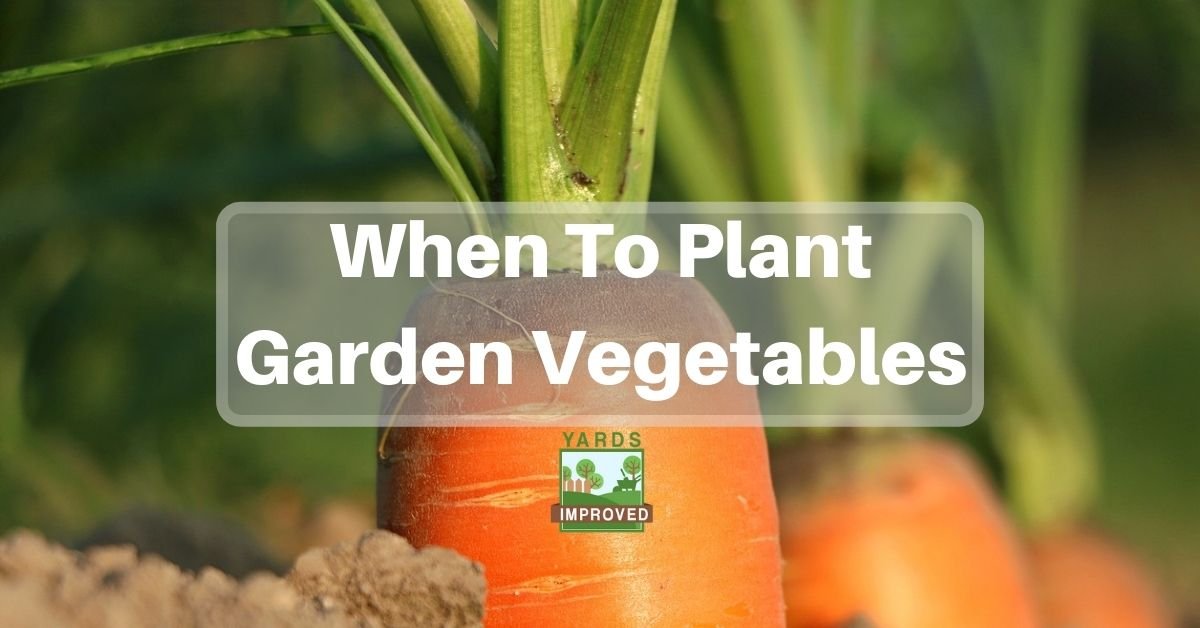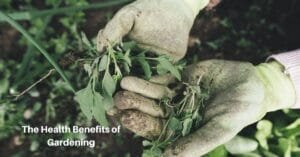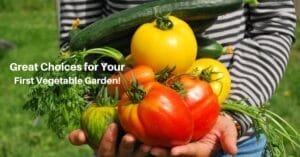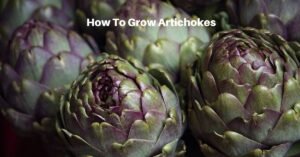Looking forward to a great vegetable garden? One of the most important things to consider is when to plant. Every plant has its own tolerances and needs, so it’s key to know when they should go in the ground.
Of course, not all our readers live in the same place, and weather conditions will vary. That means we’ll have to talk in general terms. We’ll also refer to the US Department of Agriculture’s climate zones. These help identify similar climates in different parts of the US and parts of Canada.
A vegetable garden and its produce can be a great source of pride. So let’s see how to get it started right so that it will produce healthy and abundant veggies for the table!
Want to know when to plant flowers and ornamental plants?
Find Out What Hardiness Zone You Live In
The first step is to find out what hardiness zone you live in. This will help you identify the plants that will thrive in your area.
Check out the USDA hardiness zone map. The website isn’t the most modern, but it still works!

Be sure to click on your state to see it in detail. Many states have various climate zones based on elevation and other factors. While there are always border areas that don’t fit clearly in one zone or another, this map will help you identify what you should plant.
As you can see, the zones that cover the continental US are 3 – 10. Zone 3 is the northernmost and Zone 10 the southernmost. Each of these only affect small areas. The zones run roughly in bands across the map, but they are irregular, and you may find yourself in Zone 6, for example, even though 10 miles in every direction it would be Zone 8.
The warmer zones obviously will allow you to start planting earlier in the year, even in January. If you’re in a lower-numbered zone, though, you probably wouldn’t even be able to turn the frozen soil over yet.
Check out these 11 great vegetables to grow at home!
What To Plant and When
Let’s have a look at when to plant vegetables, based on your zone.
To start, here are some that can be planted in April in any zone. The weather is still mild, there’s a good amount of moisture, and the heat won’t destroy struggling young sproutlings
- Beans – both pole beans and bush beans
- Beets
- Cabbage
- Carrots
- Corn
- Cucumber
- Eggplant
- Lettuce
- Melons
- Onions
- Peas – green peas and sugar peas
- Peppers
- Summer Squash
- Tomatoes
April is the peak planting month across all zones. For what you should plant the rest of the year, just expand your zone’s tab below!
January
Herbs (indoor). Parsley, thyme, basil, chives, and oregano can thrive indoors. Planting them now will help them be ready throughout the year
February
Herbs again – this time, try French thyme, broadleaf sage, greek oregano, Italian basil
Onions – but only short-day varieties like Georgia sweet and Texas sweet white.
May
In Zones 3 -5, you can continue planting what you would plant in April. The weather’s still great for any of these!
June
You get to plant watermelons in June, but it’s a bit late for some others like tomatoes and onion.
- Beans – both pole beans and bush beans
- Beets
- Cabbage
- Carrots
- Corn
- Cucumber
- Eggplant
- Herbs, if you want to have an outdoor herb garden. Oregano, dill, and basil love the warmer temperatures!
- Lettuce
- Melons
- Peas – green peas and sugar peas
- Potatoes
- Summer Squash (including zucchini)
- Watermelons
July
The hotter weather brings some more changes, but you still have amply opportunity for planting in these zones. It’s good for planting:
- Beans
- Brussels Sprouts
- Broccoli
- Carrots
- Corn
- Cucumbers
- Kale
August
Even in the dog days of summer, there are still some veggies you can plant!
- Beans
- Cucumbers
- Kale
- Lettuce
- Green Peas and Sugar Peas
- Radishes
- Spinach
September
As fall approaches, it’s time to think of plants that will thrive even as the weather starts to cool off.
- Blueberries
- Broccoli
- Garlic
- Lettuce
- Radishes
- Spinach
October
Garlic can be planted in October and will yield a spring harvest. You can also work on your indoor herb garden!
November
Hopefully you’re enjoying some of your harvest still! There are fewer options for planting at this time of year, though.
However, alfalfa sprouts or broccoli sprouts do well and can add some extra taste to your meals!
December
As you can imagine, options are kind of limited at the end of the year! If you’ve done canning, though, it’s time to enjoy the results of the year’s hard work. And you can always work on your indoor herb garden!
You can get a bit of a head start on some vegetables in zone 5!
January
Herbs (indoor). Parsley, thyme, basil, chives, and oregano can thrive indoors. Planting them now will help them be ready throughout the year
February
- Herbs again – this time, try French thyme, broadleaf sage, greek oregano, Italian basil
- Onions – but only short-day varieties like Georgia sweet and Texas sweet white.
- March
- Broccoli
- Cabbage
- Carrots
- Cauliflower
- Cucumbers
- Eggplants
- Lettuce
- Onions
- Peas, both green and sugar
- Peppers
- Spinach
- Summer Squash
- Tomatoes
- Herbs can be moved outdoors
May
Didn’t get everything done in April? Just keep going! May weather is usually great for the same plants.
June
You get to plant watermelons in June, but it’s a bit late for some others like tomatoes and onion.
- Beans – both pole beans and bush beans
- Cabbage
- Carrots
- Corn
- Cucumber
- Eggplant
- Herbs, if you want to have an outdoor herb garden. Oregano, dill, and basil love the warmer temperatures!
- Lettuce
- Melons
- Peas – green peas and sugar peas
- Potatoes
- Summer Squash
July
The hotter weather brings some more changes, but you still have amply opportunity for planting in these zones. It’s good for planting:
- Beans
- Brussels Sprouts
- Broccoli
- Carrots
- Corn
- Cucumbers
- Kale
August
Even in the dog days of summer, there are still some veggies you can plant!
- Beans
- Cucumbers
- Kale
- Lettuce
- Green Peas and Sugar Peas
- Radishes
- Spinach
September
As fall approaches, it’s time to think of plants that will thrive even as the weather starts to cool off.
- Blueberries
- Broccoli
- Garlic
- Lettuce
- Radishes
- Spinach
October
Garlic can be planted now for a spring harvest. Start on your indoor herb garden for winter, too!
November
Hopefully you’re enjoying some of your harvest still! There are fewer options for planting at this time of year, though.
However, alfalfa sprouts or broccoli sprouts do well and can add some extra taste to your meals!
December
As you can imagine, options are kind of limited at the end of the year! If you’ve done canning, though, it’s time to enjoy the results of the year’s hard work. And you can always work on your indoor herb garden!
Most of the info for Zone 6 is the same as Zone 3 – 5. But a couple changes are made.
January
Herbs (indoor). Parsley, thyme, basil, chives, and oregano can thrive indoors. Planting them now will help them be ready throughout the year
February
Herbs again – this time, try French thyme, broadleaf sage, Greek oregano, Italian basil
March
You can start moving your herbs outdoors by late March, usually.
May
Zone 6 lets you continue what you started in April into May. You can also add potatoes to the mix around this time!
June
You get to plant watermelons in June, but it’s a bit late for some others like tomatoes and onion.
- Beans – both pole beans and bush beans
- Beets
- Cabbage
- Carrots
- Corn
- Cucumber
- Eggplant
- Herbs, if you want to have an outdoor herb garden. Oregano, dill, and basil love the warmer temperatures!
- Lettuce
- Melons
- Peas – green peas and sugar peas (as long as it’s not extremely hot)
- Potatoes
- Summer Squash
- Watermelons
July
The hotter weather brings some more changes, but you still have amply opportunity for planting in these zones. It’s good for planting:
- Beans
- Brussels Sprouts
- Broccoli
- Cucumbers
- Kale
August
Even in the dog days of summer, there are still some veggies you can plant!
- Beans
- Cucumbers
- Kale
- Lettuce
- Green Peas and Sugar Peas
- Radishes
- Spinach
September
As fall approaches, it’s time to think of plants that will thrive even as the weather starts to cool off.
- Blueberries
- Broccoli
- Garlic
- Lettuce
- Radishes
- Spinach
October
Garlic can be planted in October and will yield a spring harvest. You can also work on your indoor herb garden!
November
Hopefully you’re enjoying some of your harvest still! There are fewer options for planting at this time of year, though.
However, alfalfa sprouts or broccoli sprouts do well and can add some extra taste to your meals!
December
You might not face the extreme cold of the lower-numbered zones, but December still limits what you can plant. Work on your indoor herbs and enjoy the holidays!
In many ways, Zone 7 is a border zone. It’s often the limit for where certain vegetables can thrive. Most often, it seems to fit in with zones 3-6, but it may have earlier cut-offs for some plants. The zone’s milder weather may let you start some veggies earlier, too.
January
Herbs (indoor). Parsley, thyme, basil, chives, and oregano can thrive indoors. Planting them now will help them be ready throughout the year
February
- Herbs of course!
- Onions – you have enough light by now to grow long-day varieties like red creole and yellow spanish onions.
- Broccoli
- Lettuce
- Peppers
- Tomatoes
- March
- Beets
- Broccoli
- Herbs (outdoors)
- Potatoes
May
Didn’t finish your April plantings? Keep working on it this month! Potatoes are still good to plant, too.
June
You get to plant watermelons in June, but it’s a bit late for some others like tomatoes and onion.
- Beans – both pole beans and bush beans
- Cabbage
- Carrots
- Corn
- Cucumber
- Eggplant
- Herbs, if you want to have an outdoor herb garden. Oregano, dill, and basil love the warmer temperatures!
- Lettuce
- Melons
- Peas – green peas and sugar peas
- Potatoes
- Summer Squash
- Watermelons
July
The hotter weather brings some more changes, but you still have amply opportunity for planting in these zones. It’s good for planting:
- Beans
- Brussels Sprouts
- Carrots
- Corn
- Cucumbers
- Kale
August
Even in the dog days of summer, there are still some veggies you can plant!
- Beans
- Cucumbers
- Kale
- Lettuce
- Green Peas and Sugar Peas
- Radishes
- Spinach
September
As fall approaches, it’s time to think of plants that will thrive even as the weather starts to cool off.
- Blueberries
- Broccoli
- Garlic
- Lettuce
- Radishes
- Spinach
October
Garlic can be planted in October and will yield a spring harvest. You can also work on your indoor herb garden!
November
Hopefully you’re enjoying some of your harvest still! There are fewer options for planting at this time of year, though.
However, alfalfa sprouts or broccoli sprouts do well and can add some extra taste to your meals!
December
As you can imagine, options are kind of limited at the end of the year! If you’ve done canning, though, it’s time to enjoy the results of the year’s hard work. And you can always work on your indoor herb garden!
The southern part of the country generally offers the warmest temperatures and allows a good bit more flexibility in planting. Instead of worrying about frost, here your main concern is avoiding the highest temperatures.
January
- Broccoli
- Eggplant
- Onions – start them indoors no and move outside when they reach about 5-6 inches
- Peppers
- Tomato
- Herbs (indoors)
February
- Broccoli
- Herbs (indoors)
- Lettuce
- Onions
- Peppers
- Tomatoes
- March
- Beets
- Broccoli
- Cabbage
- Carrots
- Cauliflower
- Corn
- Cucumbers
- Eggplant
- Herbs – you can start moving them outdoors!
March
- Beets
- Broccoli
- Cabbage
- Carrots
- Cauliflower
- Corn
- Cucumbers
- Eggplant
- Herbs
- Lettuce
- Melon
- Onions
- Peas
- Peppers
- Potatoes
- Spinach
- Summer Squash
- Tomatoes
May
- Beans
- Beets
- Cabbage
- Carrots
- Cucumbers
- Eggplants
- Herbs
- Melons
- Peppers
- Potatoes
- Summer Squash
- Tomatoes
June
The warmer weather in June means a number of plants won’t endure. Here’s what should hold up:
Only in Zone 8:
- Beans
- Cucumbers
Melons and Watermelons
Zones 8 – 10:
- Corn
- Herbs
- Summer Squash
July
July and August are usually the hottest months, and not much will survive planting in Zone 10.
Only in Zone 8:
- Beans (only zone 8)
- Cucumbers
Only Zones 8 – 9
- Brussels Sprouts
- Kale
August
Only Zone 8
- Beans
- Lettuce
- Spinach
Only Zones 8 – 9
- Cucumbers
- Kale
- Radishes
September
As things start to cool off, you have a bit more variety. For zones 8 – 10, you could plant:
- Blueberries
- Garlic
- Lettuce
- Radishes
- Only in zones 8-9, try:
- Broccoli
- Spinach
October
- Garlic
- Herbs
November
- Herbs
- Sprouts like alfalfa and broccoli sprouts
December
- Herbs (indoors)
- Broccoli
- Lettuce
- Radishes
- Spinach
Conclusion
A great vegetable garden can bring fantastic flavors to your table, and you can even share your bounty with friends and neighbors. But it’s important to know when to plant based on where you live. Choosing the right time will help guarantee that you get the most out of your plants!









